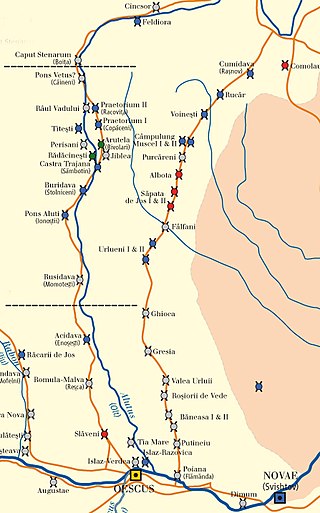
Castra Buridava was a fort in the Roman province of Dacia, part of the frontier system of the Limes Alutanus, and near the Dacian and Roman town of Buridava.
Certinae was a fort in the Roman province of Dacia.

The Castra of Albota was a castrum in the province of Dacia. It was built after 161 AD as part of the Limes Transalutanus.

The castra of Hoghiz was a fort in the Roman province of Dacia. The fort was built in the 2nd century AD, on the left bank of the Olt River, at a place where a Dacian settlement existing already in the 2nd century BC was unearthed. The fort and the nearby village were abandoned in the 3rd century AD. The ruins of the castra are located in Hoghiz, Romania.

The castra of Orheiu Bistriței was a fort in the Roman province of Dacia. It was built in the 2nd century AD. Archaeological research also identified the nearby vicus. The castra and the nearby settlement were both abandoned in the 3rd century AD. The ruins of the fort are located in Orheiu Bistriței.
It was a fort in the Roman province of Dacia and part of the Roman frontier system of the Limes Transalutanus.
The Castra of Brașov was a fort in the Roman province of Dacia near Brașov, Romania, on Șprenghi Hill.
The castra of Crâmpoia was a fort in the Roman province of Dacia. It was made of earth in the 2nd century AD. The Romans abandoned the fort in the 3rd century. Its ruins are located in Crâmpoia, Romania.
The castra of Drumul Carului was a fort in the Roman province of Dacia near Moieciu, Romania.

Apulum was a legionary fortress in the Roman province of Dacia from the 2nd to 4th centuries AD, located in today's Alba Iulia, Romania.
The castra of Fâlfani was a fort built in the 2nd century AD in the Roman province of Dacia. It was part of the Roman frontier system of the Limes Transalutanus.

Gresia Roman fort is located in the present Gresia. It was in the Roman province of Dacia and dates from the 2nd and 3rd centuries AD. It was part of the frontier system of the Limes Transalutanus.
The Castra of Izbășești was a fort made of earth in the Roman province of Dacia. Erected and abandoned at an uncertain date, the fort was part of the Limes Transalutanus. Traces of the one time earthwork can be identified on the Corbeasca Hill at Izbășești.

Although not unanimously accepted, the existence of the castra of Cristești in the Roman province of Dacia is substantiated by bricks and tiles bearing the name of a Roman military unit, the Ala I Gallorum et Bosporanorum. The lack of any other traces of the Roman fort may easily be due to its destruction by the Mureș River. At Cristeşti, a Roman settlement from the 2nd and 3rd centuries AD was unearthed which was an important center of potters.

Castra of Slăveni was a fort in the Roman province of Dacia.
It was a fort in the Roman province of Dacia.

It was a fort in the Roman province of Dacia.
The Castra of Jac was a fort made of earth in the Roman province of Dacia. It was erected in the 2nd century AD. Not far from the fort, the remains of a previous fortification and of a Roman watchtower were unearthed. The fort and the watchtower were abandoned in the 3rd century. Traces of the castra can be identified on Citera Hill in Jac.

Castra of Răcarii de Jos was a fort in the Roman province of Dacia.

Castra of Rădăcinești was a fort in the Roman province of Dacia near the Limes Alutanus on the west bank of the Olt River.
This page is based on this
Wikipedia article Text is available under the
CC BY-SA 4.0 license; additional terms may apply.
Images, videos and audio are available under their respective licenses.










